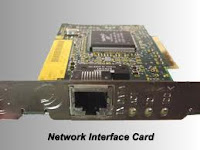 |
| Flash memories are inserted into USBs |
Graphic cards
Graphic cards are cards that allow to generate output images to a display. They are normally used to enhance the quality of the images on the computer used. For example, graphic cards are used to enhance the image quality while playing video games.
Sound cards
Sound cards facilitate the input and output of audio signals to and from the computer under the control of particular programs. It is usually used to add or provide the music component to music composition softwares, games and etc.
Network Interface Cards (NIC)
An NIC allows computers to communicate over a computer network. It serves as an interface between the networked devices and the connecting wires. It is basically a computer circuit board or card that is installed in a computer so that it can be connected to a network.
Plug and Play
Plug and Play is a term which was created by Microsoft to mean the capability to plug a device into a computer and have the computer recognize that the device is there. Therefore, unlike in the past, a device can be installed and used as part of a computer with ease.
Bus Line
The bus lines are the communicating electronic lines that connect different parts of the CPU to various other parts. In addition, the bus lines also link the CPU to different parts on the system board of your computer. The bus lines are like multilane pathway which means that the more bus lines there are on the system the greater is the rate of transfer of data along the bus, which means that the computer can run efficiently and will perform operations at a faster rate.
HDMI
HDMI stands for High-Definition Multimedia Interface. It is a digital video and audio connection system used to connect a variety of audio/video components, particularly high-definition video (HDTV). It is structured such that both HD video and digital audio can run through one HDMI cable without any loss in quality.
Cache Memory
It is a cache that is used by the CPU to reduce the average time to access memory. The cache is a smaller, faster memory which stores copies of the data from the most frequently used main memory locations. For instance, because the end user frequently opens a certain software or application, the window pops up immediately upon the switching on of the computer (MSN).






No comments:
Post a Comment